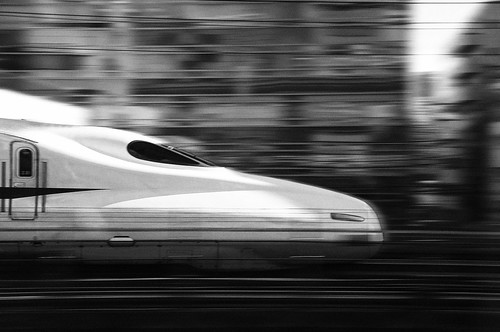Obama's $50B infrastructure plan: what it means for rail

 Americans stuck in Labor Day traffic over the weekend may have found themselves pondering the virtues of rail travel. A regular NJ Transitpassenger myself, I can say it's not always glamorous (ear phones=necessity). But greener and cheaper than driving, and usually reliable, it is.
Americans stuck in Labor Day traffic over the weekend may have found themselves pondering the virtues of rail travel. A regular NJ Transitpassenger myself, I can say it's not always glamorous (ear phones=necessity). But greener and cheaper than driving, and usually reliable, it is.
Nations across the world offer high-speed, bullet-like trains, like Japan's Shinkansen, to issue travelers across countries and continents (i.e. Europe), but Americans have only Acela, and only in the Northeast at that. On the congested trails between Boston and Washington, D.C., these 150 mile-per-hour trains seldom achieve their top speeds.
President Obama announced plans yesterday in Milwaukee for overhauling the country's transportation infrastructure, to the tune of $50 billion. In addition to rebuilding 150,000 miles of the nation's roadways and refurbishing 150 miles of airport runways over the next six years, the Obama Administration laid plans to construct 4,000 miles of railroad lines. Hopefully, much of this track will carry faster trains.
After spending upwards of $8 billion from Recovery Act funds on the high-speed rail endeavor, the Administration hopes the trains will escort commuters to their jobs faster, as well as create jobs for Americans to go to. Foreign companies will no doubt play roles in America's high-speed rail future, but to promote a domestic industry, the Department of Transportation announced last week system-wide manufacturing standards for bi-level rail cars (and later single-level cars).
A uniform standard creates a level playing field and economies of scale based on a common set of designs and technical requirements allowing U.S. based manufacturers to more effectively compete. Fostering healthy economic competition will drive down costs for rail owners and operators and the traveling public. Further, maintenance and repair costs will be lower because of lower parts acquisition costs. And, training can be streamlined with just one type of equipment, allowing faster turnaround for repairs.
Despite some political and local community speed bumps, by 2015 high-speed trains may be gliding on rails between San Francisco and Los Angeles in California and Tampa and Orlando in Florida by 2015. Other inter-city rail projects are also receiving funding, which points to the question of how much more money and steady investment is needed for a nationwide high-speed network. And where it will come from.
Sheryl Gay Stolberg reports for The New York Times:
The administration said it would work with Congress to find ways to pay for the plan so that it would not add to the nation’s rising deficit. The White House is proposing to cut tax breaks and existing subsidies for oil and gas exploration and production as one way to pay for the plan, but officials said Mr. Obama is open to other ideas. Historically, transportation projects have been paid for largely with dedicated taxes like those on gasoline.
Mr. Obama also called for what the White House is describing as an “infrastructure bank” that would focus on paying for national and regional transportation projects by pooling private money with public investment. He said the bank would eliminate a patchwork system in which transportation projects are financed through Congressional earmarks rather than based on merit.
TheFederal Railroad Administration is expected to release a report sometime this month. As for the rest of Obama's infrastructure initiative, it may have a slow time getting passed by Congress this fall.
Image: Flickr_sinkdd
Related on SmartPlanet:
- High-speed rail federal report warns of missing links
- California's high-speed-rail debate heats up
- Five reasons high-speed rail can boost business by 2035
- The new arms race: China planning high-speed rail network to Russia, India, Europe
- Spain's high-speed rail: comfort and convenience trump green
This post was originally published on Smartplanet.com